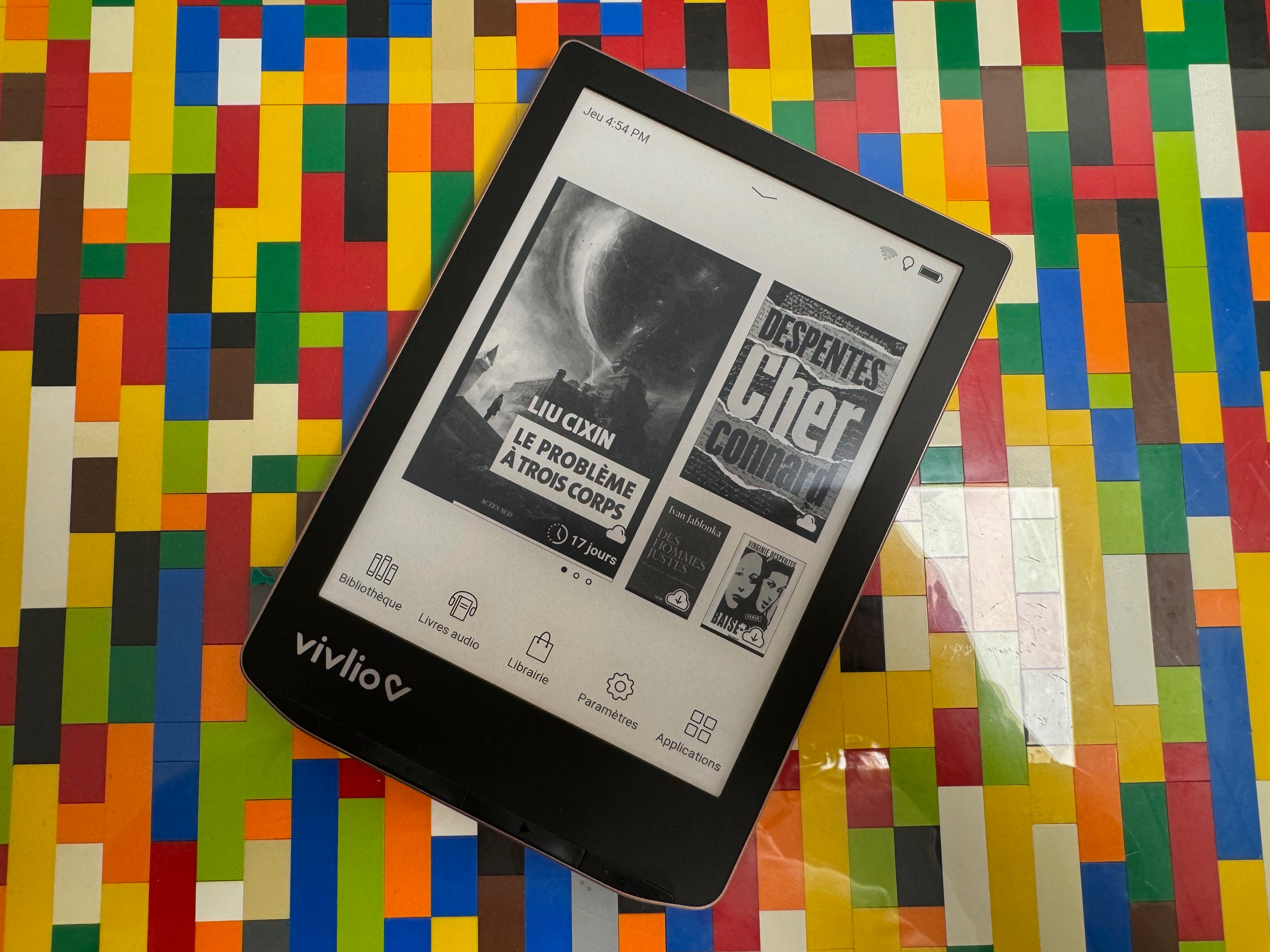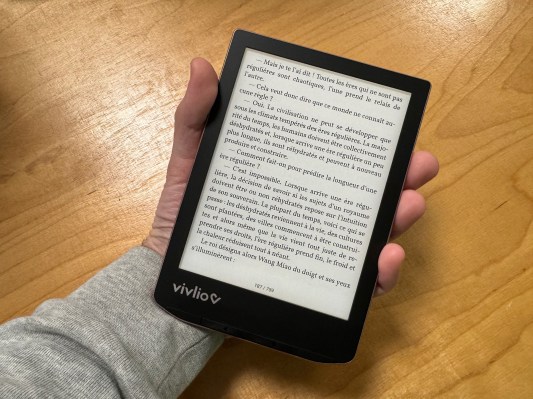For the past decade, three companies have been building full-fledged e-book ecosystems with devices, apps and digital bookstores all working perfectly together — Amazon, Rakuten and a tiny company called Vivlio.
While Amazon’s Kindle is the clear leader and Rakuten’s Kobo the obvious challenger, Vivlio has been building an open European alternative to these two tech giants. And it proves that you can compete with tech giants with a team of 35 as long as you have a distinct strategy with different goals.
Vivlio was incorporated in 2011, just a year after Kobo released its first e-book reader. At first, Vivlio was a side project from Decitre, a bookstore chain from the Lyon area. Just like Barnes & Noble in the U.S., Decitre wanted to start selling e-books so that it would address all your reading needs.
But Vivlio chose a different path as it immediately decided that it wanted to build a bookstore-agnostic e-book platform. Cultura, one of the biggest booksellers in France, became a shareholder.
“The idea was to create a European coalition — well, French at first, but we’re trying to make it European now — a coalition of companies with similar interests, booksellers and retailers of cultural goods, around a French and then European solution,” Vivlio CEO David Dupré told me.
Turning bookshops into e-book sellers
Bookshops existed long before the inception of Amazon. But Amazon didn’t partner with existing bookstores to deliver books to your home. While Amazon has managed to capture a large market share of book sales, bookshops still exist.
In some countries, including many European countries, fixed book prices have even helped independent bookstores remain in business. That’s why the book industry is still a highly fragmented industry in Europe, with large e-commerce retailers, big chain bookstores and independent shops.
From the very beginning, Vivlio bet that the book industry would remain fragmented — building yet-another-Amazon wouldn’t be a winning move. Vivlio signed a handful of partnerships with small and big chain bookstores so that it could run their e-book stores for them.

Image Credits: Romain Dillet / TechCrunch
In France, in addition to Decitre and Cultura, Vivlio has also partnered with Decitre’s sister company Furet du Nord and Leclerc. Vivlio is also working with the leading chain bookstores in Belgium and Spain, Standaard Boekhandel/Club and Casa del Libro, respectively. So if you’ve bought an e-book on one of those websites, Vivlio handled that transaction on behalf of those retailers.
“The fundamental principle of the Vivlio model, which really sets us apart from Kobo, for example, which has a partnership with Fnac, is that we guarantee two things to our partners. First, the customer remains their customer. This means that the customer account is a bookseller’s customer account, not a Vivlio customer account,” Dupré said.
“Second, a very large portion of the sales generated by the Vivlio ecosystem go to the bookseller. In other words, we leave most of the margin to the reseller . . . That’s the contractual, legal and operational promise,” he added.
User-friendly e-books
While Vivlio only takes a small cut on each e-book sale, it still represents the majority of the company’s revenue. But selling e-books is one thing. You have to provide ways to read these e-books after that.
The French company quickly understood that it needed to sell its own e-book readers so that buyers could download and read their books on a dedicated device. Once again, instead of designing an e-book reader from scratch, Vivlio partnered with an existing manufacturer, PocketBook — more on that later.
Selling e-books has also represented a technical challenge for the company. The dominant file format for e-books is called epub — even recent Kindle devices now support epub books. So naturally Vivlio is selling epub files.
But book publishers often require a protection method (a DRM) to make sure that e-books don’t end up on the internet just a few days after the official release. While Amazon, Rakuten, Apple and Google have all designed their own DRM layer, most third-party e-book sellers rely on Adobe’s DRM system.
But Adobe’s DRM hasn’t evolved in years. It’s clunky, hostile to the end user and Adobe takes a cut on each transaction. “The company literally almost died because of [Adobe’s DRM] as we were having major problems. It accounted for 80% of our customer support requests,” Dupré said.
Vivlio contributed to Readium LCP, an open-source DRM solution that doesn’t require an Adobe account (or any third-party account). Many companies and public institutions have embraced LCP in recent years. Adobe’s DRM is still the leading protection system, but this technical move contributes to the open ecosystem philosophy behind Vivlio.
Adding e-book readers to the ecosystem
Vivlio partners with PocketBook for its e-book readers. But these devices aren’t just rebranded PocketBook devices, as the company adds a software layer so that they work with the entire Vivlio ecosystem. For instance, you can log in to your bookstore account directly on your Vivlio e-reader. All your purchases are automatically synchronized with your device and Vivlio’s cloud storage.
Vivlio currently has three e-book readers in its product lineup. There’s the entry-level Vivlio Light e-reader with a six-inch display and a color-adjustable front light. There’s the improved version of that reader, the Vivlio Light HD. And there’s a bigger e-reader called the Vivlio InkPad 4. This one has a 7.8-inch display.
I have been testing the Vivlio Light HD for the past few weeks, and it’s exactly what you would expect from an e-reader in 2023. With a 300dpi screen, the text is sharp and highly readable. The battery lasts several weeks, even when you use the front light. There’s a USB-C port for charging, built-in Wi-Fi connectivity and a ton of customization options for the interface, gestures and typography.

Image Credits: Romain Dillet / TechCrunch
It’s also worth noting that there are tiny physical buttons at the bottom of the device — physical buttons are uncommon with e-readers these day. Overall, it’s a small reading device that you can carry with you everywhere you go.
There are other features, such as a web browser, a calendar and some simple games like solitaire. But in the smartphone era, e-readers are good for one thing — reading. If you’re an intense reader and don’t want to carry a pile of books with you on your next vacation, this device works extremely well.
A neutral player
Vivlio positions itself as a neutral player in the e-book industry. While Cultura is now the main shareholder, it still has a handful of minority shareholders from the industry. For instance, Divibib is a recent addition on Vivlio’s capitalization table.
Divibib isn’t a bookstore, it’s a company that works tightly with public libraries in Germany. As you may have guessed, you can use a Vivlio e-reader to borrow books from German libraries. Once again, that’s because digital lending is another form of e-book reading.
“The company isn’t going to be integrated into a group. The idea is to create an alliance of European partners. The capital is also structured in this way. It’s not open to everyone, but when we have major partners, there may be discussions to add them as shareholders,” Dupré said.
Vivlio is well aware that it is never going to be as big as Amazon or Rakuten. But the company estimates that it has hundreds of thousands of active users. It’s not a huge number, but there are only 35 people working for the company.
More importantly, there’s a lot of room for growth. As people start looking at e-books as a way to supplement their reading habits, Vivlio provides several entry points into its ecosystem. It’s an interesting business case that illustrates differentiated positioning.

Image Credits: Romain Dillet / TechCrunch
